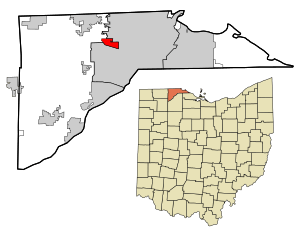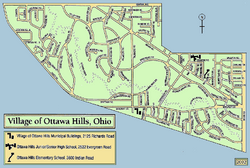Ottawa Hills, Ohio facts for kids
Quick facts for kids
Village of Ottawa Hills
|
|
|---|---|
|
Village
|
|

Location in Lucas County and the state of Ohio.
|
|

Street-level map of Ottawa Hills
|
|
| Country | United States |
| State | Ohio |
| County | Lucas |
| Area | |
| • Total | 1.90 sq mi (4.91 km2) |
| • Land | 1.88 sq mi (4.87 km2) |
| • Water | 0.02 sq mi (0.04 km2) |
| Elevation | 610 ft (190 m) |
| Population
(2020)
|
|
| • Total | 4,790 |
| • Density | 2,546.52/sq mi (983.35/km2) |
| Time zone | UTC−5 (EST) |
| • Summer (DST) | UTC−4 (EDT) |
| FIPS code | 39-59010 |
| GNIS feature ID | 1086530 |
Ottawa Hills is a small village located in Lucas County, Ohio, United States. In 2020, about 4,790 people lived there. The village was built on both sides of the Ottawa River. It's often called a "bedroom community" because many people who live there travel to nearby Toledo for work.
Contents
History of Ottawa Hills
The Village of Ottawa Hills started being developed in 1915. John North Willys, who was the president of a company called Overland, bought a large area of land. This land was about 1,200 acres (4.9 square kilometers) and stretched along the Ottawa River.
He began building the village that same year. News reports from 1915 said that many experts, like landscape architects and city planners, worked on the land. They had already finished improving the first 100 acres (0.4 square kilometers). A big part of the land, about 35%, was set aside for parks. This included the wooded areas along the river.
John North Willys worked with the E. H. Close Realty Company to develop Ottawa Hills. This company had experience developing over 1,000 acres (4.0 square kilometers) in the Toledo area. Famous planners and architects helped design the village. They also set up special rules to make sure that all the homes built were of high quality.
Over time, Ottawa Hills has grown through new areas being added. Many parts of the village still follow the original plans from 1915. The oldest homes are often found in the first area that was developed.
The Ottawa Hills school district is well-known for its excellent student performance. In the 2007–2008 school year, it was ranked first in the state of Ohio.
Geography of Ottawa Hills
Ottawa Hills covers a total area of about 1.87 square miles (4.84 square kilometers). Most of this area, about 1.85 square miles (4.79 square kilometers), is land. A small part, about 0.02 square miles (0.05 square kilometers), is water.
Population Information
| Historical population | |||
|---|---|---|---|
| Census | Pop. | %± | |
| 1930 | 1,185 | — | |
| 1940 | 1,970 | 66.2% | |
| 1950 | 2,333 | 18.4% | |
| 1960 | 3,245 | 39.1% | |
| 1970 | 4,270 | 31.6% | |
| 1980 | 4,065 | −4.8% | |
| 1990 | 4,543 | 11.8% | |
| 2000 | 4,564 | 0.5% | |
| 2010 | 4,517 | −1.0% | |
| 2020 | 4,790 | 6.0% | |
| U.S. Decennial Census | |||
Village Demographics
In 2010, there were 4,517 people living in Ottawa Hills. These people lived in 1,740 households. About 37.6% of these households had children under 18 living with them. Most households, 63.1%, were married couples.
The average age of people in the village was 43.6 years old. About 28.6% of residents were under 18. Also, 16.2% of residents were 65 years old or older.
Homes in Ottawa Hills
The typical price for a house in Ottawa Hills is around $254,800. Many of the homes are quite old, with 30% built before 1939. The houses in the village are generally large. About 74.2% of homes have eight or more rooms. Also, 40% of homes have four bedrooms, and 12.8% have five or more bedrooms.
Notable People
- Conrad Kennedy III – a professional wrestler
- Ernest M. McSorley – the last captain of the ship SS Edmund Fitzgerald
- Tom Scholz – a guitarist and founder of the rock band Boston
See also
 In Spanish: Ottawa Hills (Ohio) para niños
In Spanish: Ottawa Hills (Ohio) para niños

